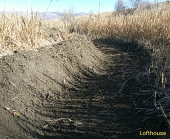You live in a semi-arid area dont do raised beds, all the water is doing to drain to the lower elevation, which would be good in super wet PNW or the swamps of FL, but never good in the SW.
Not only do raise bed drain the water away it also has a higher evaporation rate.
Due to your shallow soil you are going to have to plant the stuff in 1 inch depression
More like 2inch, in the center the soil is 5inch deep and the 1nch that you remove you can put at the edge where the soil will be 7inch deep. that will also make the water "flow" to the center vs away at the edge.
6 inch of soil is more than enough for your veggies and 15ft fruit/nut trees, all you really have to worry about is mulching the soil to keep it covered.
On 1 acre you could plant 180 15ft trees plus hundreds more as a living
fence.
Semi-Arid soil are supper fertile, filled with calcium, iron, etc.
And your soil have rocks so it is porous already , so all you now have to do is cut evaporation by mulching.
You can also use a living non-rooting vine mulch like grape, kiwi, passionfruit, wild/bitter melon have it run on the ground and keep the root well watered and fertilized. Each plant can "mulch" a 100ft circle.
Semi-Arid soils are not very forgiving to annuals so you might have to focus on fruits like figs and nuts like almonds vs lettuce and water celery.
If you really must grow annuals a aquaponic system might be a better option.
You can also build shallow "wet" swales and have the elevated dry area as catchment area for the depressed swales.
lasagna on hilly semi-arid soil will not improve the soil, it will prevent the roots from going deeper to access water. It will also prevent the water from soaking in deeper and thus the water to stop at the paper and "run off" to the edge where it will be further from the plant roots and closer to the soil thus evaporate faster
If you have the machinery and money and time then add the organic matter, but you dont really need it all you really need is mulch to cut your evaporation rate.





























